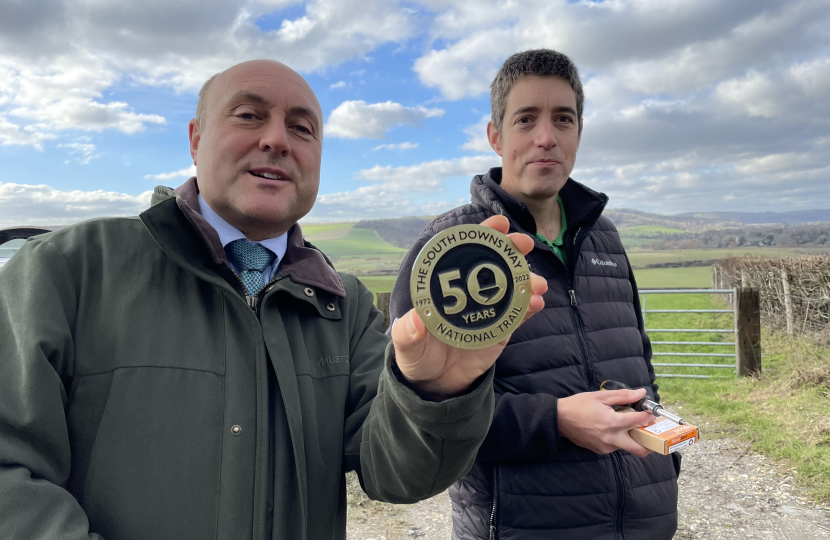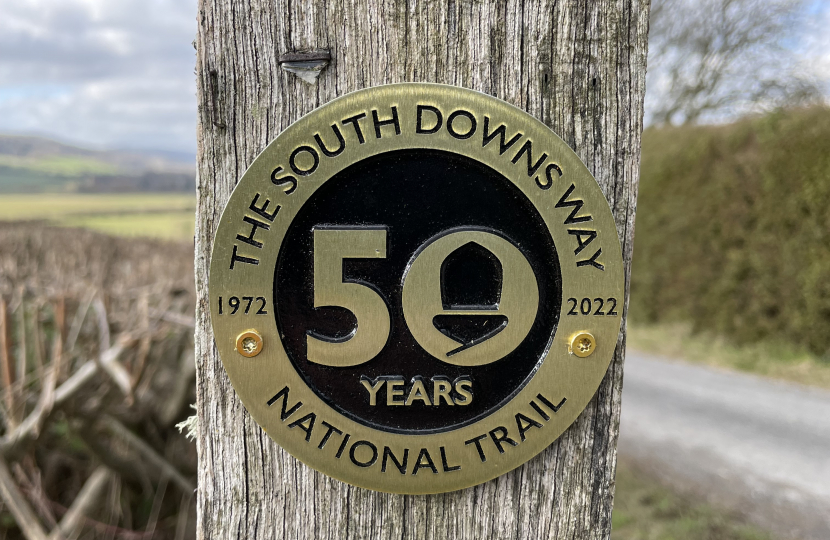Andrew Griffith MP joined Andy Gattiker from South Downs National Park Authority to install a commemorative waymarker at the Amberley point of the South Downs Way, marking 50 years of the much-loved national trail.
The 100-mile route of the South Downs Way is a hilltop national trail running along the chalk ridge of the South Downs and passing through 66 parishes. The Amberley fingerpost was one of the last parish posts to be decorated with the 50th anniversary plaque and marks the end of the project.
On 15 July 1972 it was officially opened as the South Downs Way National Trail, making it the UK’s fifth national trail to be established and its first long-distance bridleway.
Amberley is one of the few points where walkers can access the trail by train (Amberley station, Arun Valley Line)), making it an important gateway to the South Downs National Park.
Andy Gattiker, National Trails & Rights of Way Lead, said:
“We couldn’t maintain the route without the help of dedicated volunteers, who get involved in surveying, practical work, helping at public events and administration, so a big thank you to them. We thought it would be a nice gesture for each of the parishes along the route to get a beautiful waymarker that can be attached to a fingerpost to celebrate 50 years.”
Andrew Griffith said:
“It was a privilege to be invited to hang the final plaque in this commemorative series, and at such a beautiful spot. The views from Amberley on the South Downs Way are majestic. We should all be incredibly proud to have such a wonderful and free amenity right on our doorsteps.”
ENDS
Notes:
- Photograph 1 – Andrew Griffith MP and Andy Gattiker, National Trails & Rights of Way Lead (SDNPA) with the commemorative waymarker. Taken at Amberley.
- Photograph 2 – Andrew Griffith MP and Andy Gattiker, National Trails & Rights of Way Lead (SDNPA) with the commemorative waymarker. Taken at Amberley.
- Photograph 3 – The commemorative waymarker in situ at Amberley.
- To celebrate the anniversary, Andy Gattiker has provided 10 interesting facts about the National Trail:
- The National Trail wasn’t always 100 miles. Initially it ran almost entirely in Sussex, from Buriton, on the Hampshire–Sussex border, to Beachy Head, near Eastbourne. In 1987 it was decided to extend the route westwards through Hampshire to Winchester.
- The recommended time to walk the South Downs Way is 8 days, with an average of 12.5miles/20km a day.
- If you fancied a crack at the world record for completing the South Downs Way on foot, you could try and beat Mark Perkins time of 14 hours, 3 minutes and 54 seconds, set in 2014 at the Centurion Running SWD 100 event.
- The fastest South Downs Way single cycle ride is Ian Leitch at 7 hrs 3 mins, while Ian also holds the record for the fastest double cycle ride at 15 hrs 35 mins.
- The route has stood the test of time. Humans have been using the tracks that have been linked to form the South Downs Way for around 8,000 years as its elevation made it a safer and drier route than the wetter lowlands. The route is dotted with Iron Age forts such as Old Winchester Hill and Cissbury Ring.
- The fastest non-motorised wheelchair user to complete the route is Swasie Turner in 9 days.
- In 2021 Neil Laughton and Tom Clowes took on the South Downs Way – riding on a penny farthing and a unicycle.
- Ditchling Beacon is one of the most famous hills on the trail and was used to warn Queen Elizabeth I of the Spanish Armada that could be seen sailing up the English Channel.
- Just off the chalk path is a biodiversity oasis. Chalk grassland is known as “Europe’s rainforest in miniature” and can have up to 40 different wildflowers and over 20 different butterfly – and that’s just within one square metre.
- It’s very accessible by train or bus! Step off the train at Southease, Amberley or Winchester and you can be on the South Downs Way within minutes! Check out our useful guide on accessing the South Downs Way by public transport.


